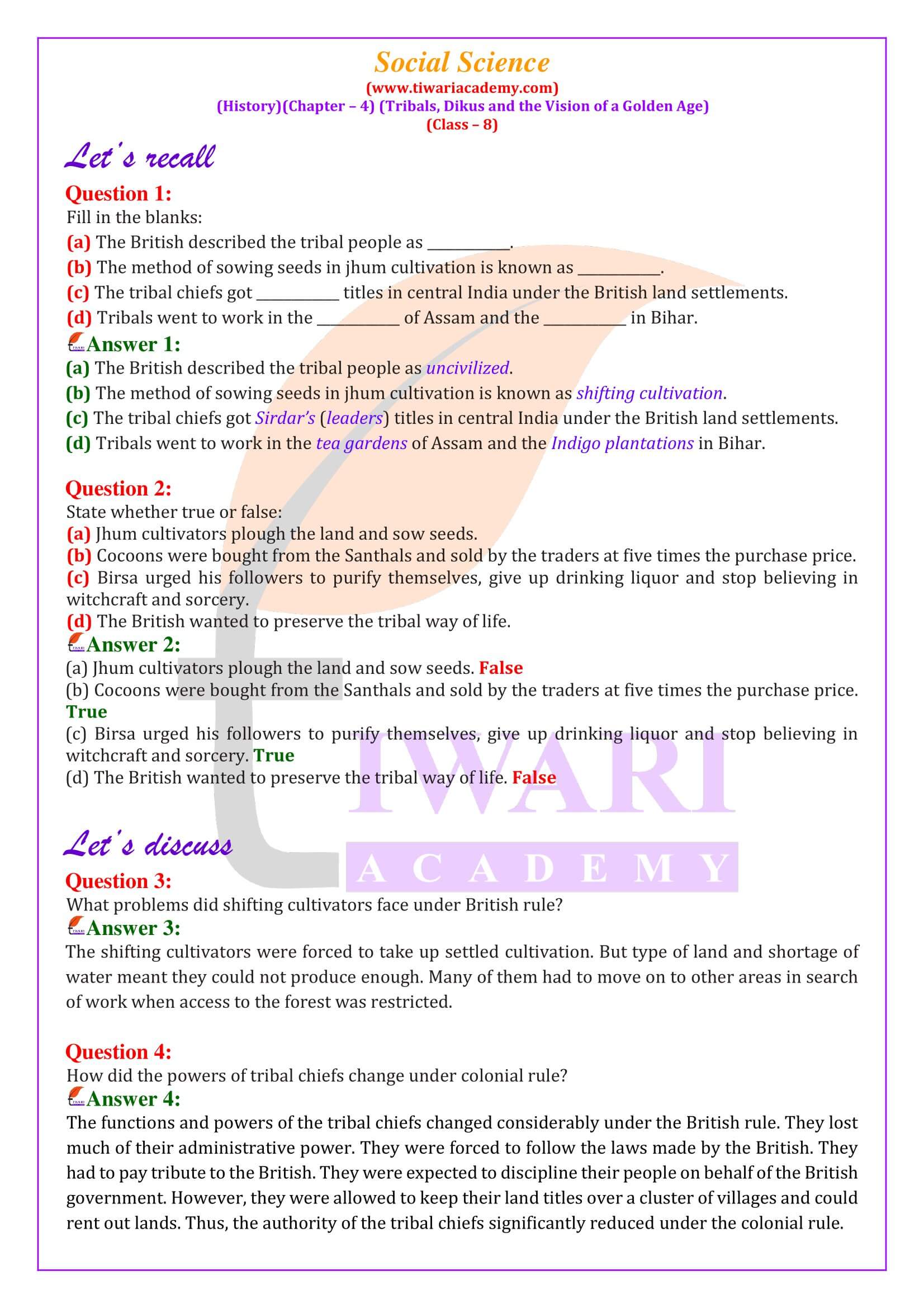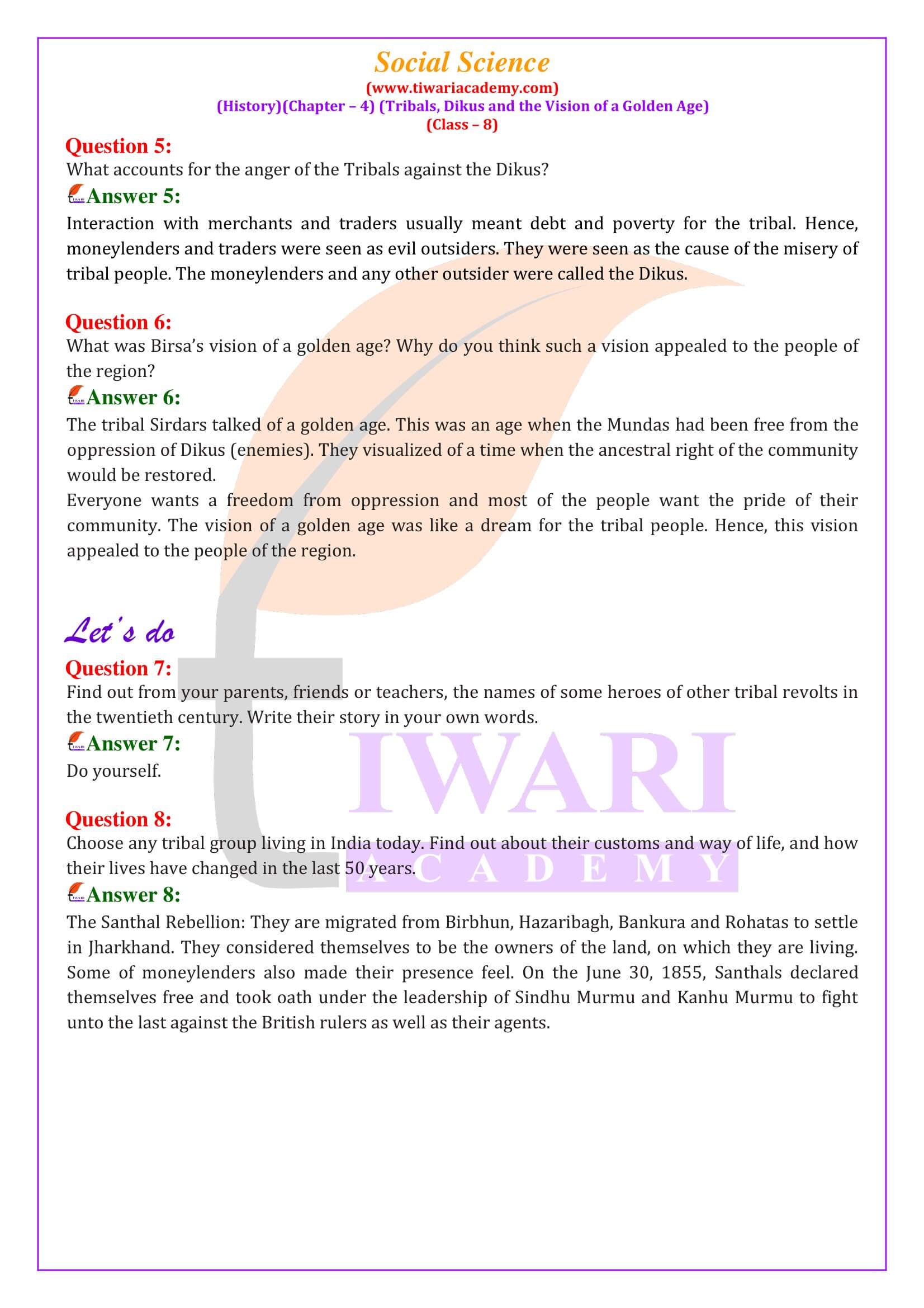NCERT Solutions for Class 8 Social Science History Chapter 4 Tribals, Dikus and the Vision of a Golden Age in English and Hindi Medium updated for academic session 2025-26. Question answers and solutions of class 8 History chapter 4 are revised and modified according to rationalised NCERT books issued for 2025-26 exams.
NCERT Solutions for Class 8 Social Science History Chapter 4
Downloads of NCERT Books 2025-26 for class 8 all subjects in Hindi and English Medium. Share Your View through Discussion Forum with your friends and followers.
Class 8 History Chapter 4 Extra Questions
Who was Birsa?
Birsa was born in a family of Mundas – a tribal group that lived in Chottanagpur.
What is JHUM Cultivation?
Some of them practised jhum cultivation, which is shifting cultivation. The cultivators cut the treetops to allow sunlight to reach the ground and burnt the vegetation on the land to clear it for cultivation. They spread the ash from the firing, which contained potash, to fertilise the soil. They used the axe to cut trees and the hoe to scratch the soil in order to prepare it for cultivation. They broadcast the seeds, that is, scattered the seeds on the field instead of ploughing the land and sowing the seeds. Once the crop was ready and harvested, they moved to another field. A field that had been cultivated once was left fallow for several years.
Who were Khonds?
The Khonds were such a community living in the forests of Orissa. They regularly went out on collective hunts and then divided the meat amongst themselves. They ate fruits and roots collected from the forest and cooked food with the oil they extracted from the seeds of the sal and mahua. They used many forest shrubs and herbs for medicinal purposes, and sold forest produce in the local markets. The local weavers and leather workers turned to the Khonds when they needed supplies of kusum and palash flowers to colour their clothes and leather.
Class 8 History Chapter 4 Question Answers
CBSE NCERT Solutions for Class 8 Social Science History Chapter 4 Tribals, Dikus and the Vision of a Golden Age is given below in updated format for session 2025-26. Download NCERT Solutions App for offline use or use as it is without downloading online. Visit to Discussion Forum to ask your doubts.
| Class: 8 | Social Science |
| Subject: | History |
| Chapter 4: | Tribals, Dikus and the Vision of a Golden Age |
| Content: | NCERT Exercise Question Answers |
| Content Type: | Online Text and Images |
Important Questions on 8th History Chapter 4
Fill in the blank: The British described the tribal people as ____________.
The British described the tribal people as uncivilized.
State whether true or false: Jhum cultivators plough the land and sow seeds.
Jhum cultivators plough the land and sow seeds. False
What problems did shifting cultivators face under British rule?
The shifting cultivators were forced to take up settled cultivation. But type of land and shortage of water meant they could not produce enough. Many of them had to move on to other areas in search of work when access to the forest was restricted.
How did the powers of tribal chiefs change under colonial rule?
The functions and powers of the tribal chiefs changed considerably under the British rule. They lost much of their administrative power. They were forced to follow the laws made by the British. They had to pay tribute to the British. They were expected to discipline their people on behalf of the British government. However, they were allowed to keep their land titles over a cluster of villages and could rent out lands. Thus, the authority of the tribal chiefs significantly reduced under the colonial rule.
What accounts for the anger of the Tribals against the Dikus?
Interaction with merchants and traders usually meant debt and poverty for the tribal. Hence, moneylenders and traders were seen as evil outsiders. They were seen as the cause of the misery of tribal people. The moneylenders and any other outsider were called the Dikus.
What was Birsa’s vision of a golden age? Why do you think such a vision appealed to the people of the region?
The tribal Sirdars talked of a golden age. This was an age when the Mundas had been free from the oppression of Dikus (enemies). They visualized of a time when the ancestral right of the community would be restored. Everyone wants a freedom from oppression and most of the people want the pride of their community. The vision of a golden age was like a dream for the tribal people. Hence, this vision appealed to the people of the region.
Choose any tribal group living in India today. Find out about their customs and way of life, and how their lives have changed in the last 50 years.
The Santhal Rebellion: They are migrated from Birbhun, Hazaribagh, Bankura and Rohatas to settle in Jharkhand. They considered themselves to be the owners of the land, on which they are living. Some of moneylenders also made their presence feel. On the June 30, 1855, Santhals declared themselves free and took oath under the leadership of Sindhu Murmu and Kanhu Murmu to fight unto the last against the British rulers as well as their agents.
Important Notes on 8th History Chapter 4
In 1895, Birsa himself declared that God had appointed him to save his people from trouble, free them from the slavery of dikus (outsiders). Soon thousands began following Birsa, believing that he was bhagwan (God) and had come to solve all their problems.
His followers included other tribals of the region – Santhals and Oraons. Their familiar ways of life seemed to be disappearing, their livelihoods were under threat and their religion appeared to be in danger.
Most tribes had customs and rituals that were very different from those laid down by Brahmans. These societies also did not have the sharp social divisions that were characteristic of caste societies. All those who belonged to the same tribe thought of themselves as sharing common ties of kinship.





